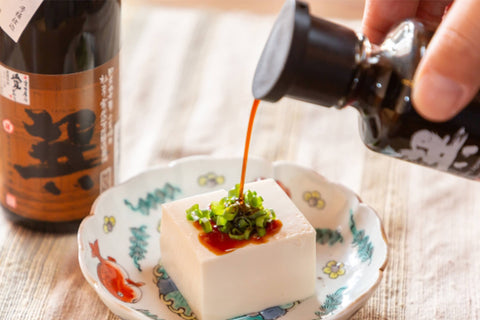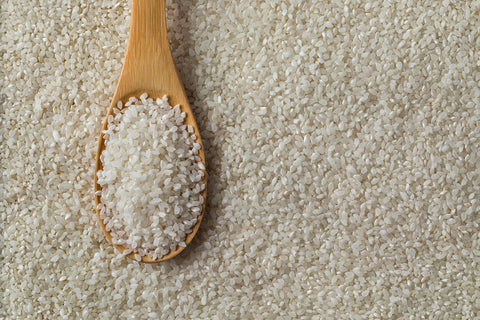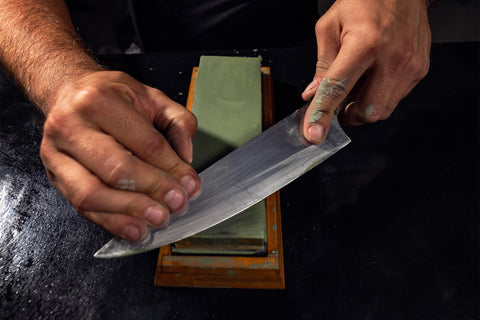
What is Soy Sauce?
Soy sauce is a liquid condiment that originated in China and which is traditionally made from grains such as soybeans and wheat and moulds from Aspergillus and Rhizopus, and is aged by mixing it with salt water. It can be added directly to food as a condiment, used as a simple dipping sauce (often mixed with ground wasabi), or incorporated into cooking. It is a long-lasting condiment that can be stored at room temperature and is a staple of many East Asian cuisines, including Japanese cooking.
History
Soy sauce dates back around 2,200 years, originating from a fermented paste obtained from soybeans that was used in China during the Western Han dynasty of the second century BCE. This precursor to soy sauce is mentioned on slips of bamboo found in the Chinese archaeological site of Mawangdui dating from this era. This traditional condiment went through several changes over the centuries, with soy sauce as we know it today appearing during the Song dynasty (960–1279 AD).
Production of soy sauce in Japan began in the 17th century, during the Edo period. They started to incorporate the same amounts of roasted wheat as soybeans with the koji. They also increased the amount of salt water, causing the fermentation of lactic acid bacteria and yeast to become more active. This became the identifying characteristic of Japanese soy sauce.
Brewing with a more vigorous fermentation process enriched the organic acid, alcohol and amino acid. This resulted in more complex flavours such as fruity scents that masked the saltiness.

Shoyu
The history of soy sauce in Japan is somewhat shorter, dating back to the 7th century and the introduction of Buddhism to the country from China. The Chinese brought a variety of soy-based products with them, including soy sauce. The Japanese recognised soy sauce (or shoyu, as they called it) is a useful ingredient and alternative to salt which was often prohibitively expensive.Soy Sauce Production
There are two ways to manufacture soy sauce – either fermentation or hydrolysis – though some commercial soy sauces are produced using a combination of these methods.

Fermentation Method
Traditional soy sauce is created by mixing soybeans and grain with various mould cultures, microorganisms, and yeast to promote fermentation. This mixture is known as koji and forms the base culture for various fermented ingredients in Japanese cuisine, including shoyu. The koji is then mixed with either brine or coarse salt and left to brew. Koji which is mixed with salt cannot be stirred but koji mixed with brine is oxygenated by stirring, promoting yeast growth and fermentation. Once the fermentation has settled down, the brewing progresses as moromi. The specific ingredients and brewing time determine the final colour, consistency and flavour of the sauce.
When brewing is complete, the fermented soybeans are left to age for the desired length of time. They are then pressed to release the liquid soy sauce, which is pasteurised by heat sterilisation to kill off any active moulds, yeasts, and other microorganisms present in the sauce. It is then bottled immediately after.
Hydrolysis
While many modern soy sauce manufacturers in Japan continue to use the traditional brewing method, some brands of soy sauce are made using an acid-hydrolysed soy protein, rather than fermenting with a koji culture. This process is much quicker than the traditional fermentation method, produced a saleable sauce in a matter of days. Hydrolysed soy sauce is also cheaper to produce and has a longer shelf-life, making is a popular method for mass-market soy sauces, intended for supermarket shelves.Flavour
The most prominent flavour in traditional soy sauce is salt, closely followed by a moderately sweet umami taste. There is a slight bitterness to soy sauce, owing to the roasted grain used in its production, but this is usually masked by other more powerful flavours.
This unique flavour profile is a direct result of the ingredients used in its production. The saltiness comes from the coarse salt or brine used in the fermentation process, while the sweetness is a consequence of the starch in the grain breaking down into sugar under hydrolysis. This is why shoyu, with its higher ratio of wheat, tends to be sweeter on the tongue. This sweetness is also the basis for lactic acid fermentation and yeast fermentation.
Japanese Soy Sauce
Japanese soy sauce differs from its Chinese counterparts in several important respects. Most Japanese soy sauces use as much wheat as soybeans as their primary ingredients. This delivers sweetness and a rich, fermented flavour to the sauce compared to Chinese varieties.
Japanese soy sauce is rich in organic acids, alcohol and amino acids. As a result, it has some unique characteristics such as its reddish colour, rich scent, and mild saltiness.
While there are many types of Japanese soy sauce, they tend to get categorised into five main varieties. These different types vary widely in terms of flavour and colour, and cannot be readily interchanged with one another. Using the right variety of shoyu us vital when following a Japanese recipe.
Tamari
Produced in the Chūbu region of Japan, tamari has a richer flavour and darker colour than koikuchi, as it contains very little wheat. It is the thickest sauce of all the varieties and closest to the soybean paste condiment originally introduced to the country from China.
Koikuchi
Koikuchi translates as ‘thick taste' and is by far the most popular type of soy sauce in Japan. Indeed, koikuchi accounts for 80% of the country’s domestic market. Originating in the Kantō region, the sauce is produced using equal quantities of soybean and wheat in each batch.
Shiro
Shiro means ‘white’, owing to its light colour and sweet taste. It is produced using small amounts of soybean, with the bulk of the ingredients being wheat. It is used for high-end Japanese cuisine, mainly as a pickling agent, and is a popular accompaniment to sashimi.
Usukuchi
Meaning ‘thin taste', usukuchi is popular in Japan’s Kansai region. It is matured for a shorter period than koichuchi, giving it a lighter colour and saltier flavour. It is commonly used as an ingredient in cooking, as it does not affect the colour of the dish.
Saishikomi
Saishikomi translates as ‘twice-brewed', and with good reason. The brine used in the brewing process is replaced with koikuchi soy sauce, with the end product being a dark and more strongly-flavoured sauce. Saishikomi is sometimes referred to as kanro shoyu, or sweet soy sauce.
Our Suppliers
Here at SushiSushi, we source our soy sauce from some of the most well-respected and established producers in Japan. These include:
Shibanuma
Shibanuma Soy Sauce is based in Tsuchiura, where it has been producing high-quality soy sauce for more than 320 years and through 18 generations. Their products are made using local ingredients and were once presented to the Edo Shogunate as one of the best soy sauces in Japan.
Yuasa
Yuasa soy sauce is brewed in the same traditional method first set down by its founder and matriarch, Ms Sumi Shinko, way back in 1881. Using all-natural ingredients and a long, slow, brewing process, their soy sauce is famous for its depth of colour, and richness of flavour.
Kajita Shoten
For almost a century and a half, Kajita Shoten has been producing soy sauce via traditional, slow-fermentation methods. By using all-natural ingredients and foregoing the addition of yeast and enzymes to speed up the process, their soy sauce can take 18 months to mature, and is well worth the wait.
Modern Japanese Soy Sauce
In addition to the traditional varieties still used by cooks across Japan, there are a couple of modern variants available. These use different brewing processes resulting in lower amounts of salt, as favoured by their target markets. These include: Gen'en: this version contains 50% less salt and is popular among consumers concerned with heart disease. Usujio: this version contains 20% less salt.















